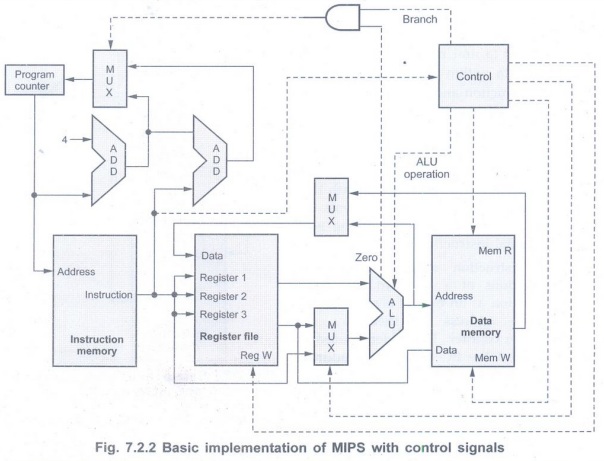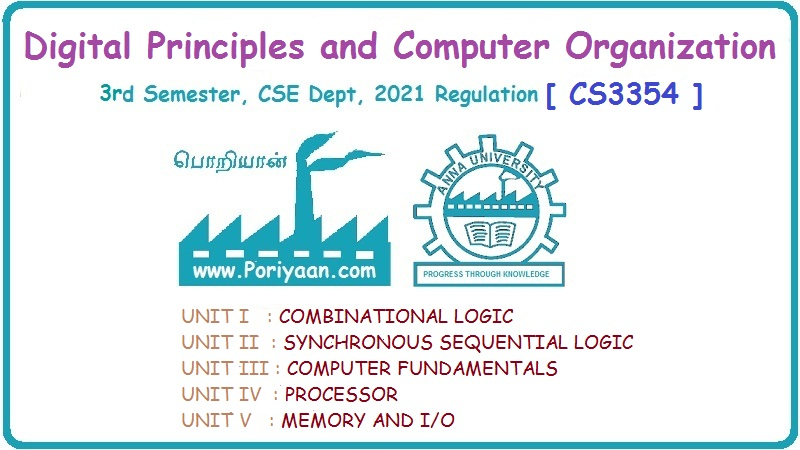Digital Principles and Computer Organization: Unit IV: Processor
Basic MIPS Implementation
Processor - Digital Principles and Computer Organization
In this chapter we will see the implementation of a subset of the core MIPS instruction set.
Basic MIPS Implementation
AU:
Dec.-15,18, May-19
• In this chapter we will see the
implementation of a subset of the core MIPS instruction set. These instructions
are divided into three classes :
• The memory-reference instructions: load
word (lw) and store word (sw)
• The arithmetic-logical instructions: add,
sub, AND, OR, and slt
• The branch instructions: branch
equal (beq) and jump (j)
•The subset considered here does not
include all the integer instructions (for example, shift, multiply, and divide
are missing), nor does it include any floating-point instructions. The key
principles used in creating a datapath and designing the control are discussed
here. The implementation of the remaining instructions is somewhat similar.
•For implementing every instruction, the
first two steps are same:
1. Fetch the instruction:
Send the Program Counter (PC) contents (address of instruction) to the memory
that contains the opcode and fetch the instruction from that memory.
2. Fetch operand(s) :
Read one or two registers, using fields of the instruction to select the
registers to read. For the load word instruction, we need to read only one
register, but most other instructions we require to read two registers.
•The remaining actions required to
complete the instruction depend on the instruction class. For each of the three
instruction classes (memory-reference, arithmetic-logical and branches), the
actions are mostly the same, independent of the exact instruction. This shows
that the simplicity and regularity of the MIPS instruction set simplifies the
implementation by making the execution of many of the instruction classes
similar.
•For example, all instruction classes,
except jump, use the Arithmetic-Logical Unit (ALU) after reading the registers.
•Memory-reference instructions use the
ALU for an address calculation
•Arithmetic-logical instructions use the
ALU for the operation execution and
•Branches use the ALU for comparison.
•After using the ALU, the actions
required to complete various instruction classes are not same.
•A memory-reference instruction needs to
access the memory either to read data for a load or write data for a store.
•An arithmetic-logical or load
instruction must write the data from the ALU or memory back into a register.
•A branch instruction may need to change
the next instruction address based on the comparison; otherwise, the PC should
be incremented by 4 to get the address of the next instruction.
•Fig. 7.2.1 shows the block diagram of a
MIPS implementation, showing the functional units and interconnection between
them.

Operation
• The program counter gives the
instruction address to the instruction memory.
• After the instruction is fetched, the
register operands required by an instruction are specified by fields of that
instruction.
• Once the register operands have been
fetched, they can be used to compute a memory address (for a load or store), to
compute an arithmetic result (for an integer arithmetic-logical instruction),
or a compare (for a branch).
• If the instruction is an
arithmetic-logical instruction, the result from the ALU must be written to a
register.
• If the operation is a load or store,
the ALU result is used as an address to either store a value from the registers
or load a value from memory into the registers. The result from the ALU or
memory is written back into the register file.
• Branches require the use of the ALU
output to determine the next instruction address, which comes either from the
ALU (where the PC and branch offset are summed) or from an adder that
increments the current PC by 4.
• Fig. 7.2.1 shows that data going to a
particular unit is coming from two different sources. For example, the value
written into the PC can come from one of two adders, the data written into the
register file can come from either the ALU or the data memory, and the second
input to the ALU can come from a register or the immediate field of the
instruction. The selection of appropriate source is done using multiplexer
(data selector). The multiplexer selects from among several inputs based on the
setting of its control lines. The control lines are set based primarily on
information taken from the instruction being executed. This is illustrated in
Fig. 7.2.2.

• Fig. 7.2.2 also shows the control unit,
which has the instruction as an input, is used to determine the control signals
for the functional units and two of the multiplexers.
• The third multiplexer, which
determines whether PC+4 or the branch destination address is written into the
PC, is set based on the Zero output of the ALU, which is used to perform the
comparison of a beq instruction.
Review Questions
1. Draw and explain the functional block
diagram for implementation of MIPS subset.
2. Draw and explain the function block
diagram with control signals for basic implementation of MIPS subset.
3. Explain the basic MIPS implementation
with necessary multiplexers and control lines. AU: Dec.-15, May-19, Marks 16
4. Write the two steps that are common
to implement any type of instruction.
AU: Dec.-18, Marks 2
Digital Principles and Computer Organization: Unit IV: Processor : Tag: : Processor - Digital Principles and Computer Organization - Basic MIPS Implementation
Related Topics
Related Subjects
Digital Principles and Computer Organization
CS3351 3rd Semester CSE Dept | 2021 Regulation | 3rd Semester CSE Dept 2021 Regulation
